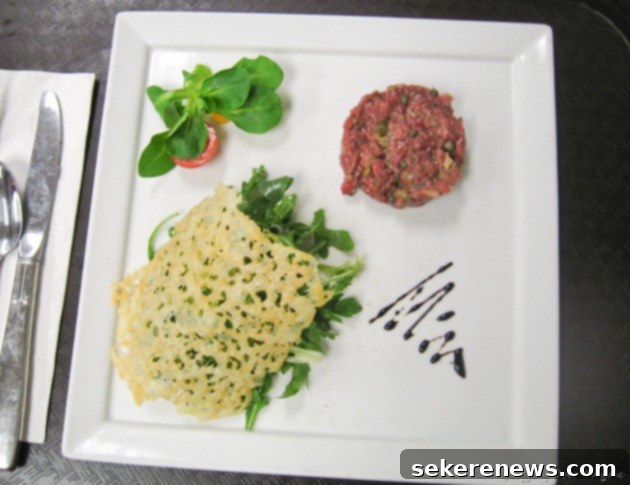Mastering Culinary Arts: Advanced Techniques and High-Stakes Challenges in Professional Training
Another whirlwind week has commenced, marking yet another stride in my culinary journey. The pace is relentless, the learning curve steep, and every day brings new dishes, techniques, and exhilarating challenges that push the boundaries of skill and creativity. From classic French preparations to vibrant Spanish fare and delicate desserts, this week’s classes have been a testament to the diverse and demanding world of professional cooking.
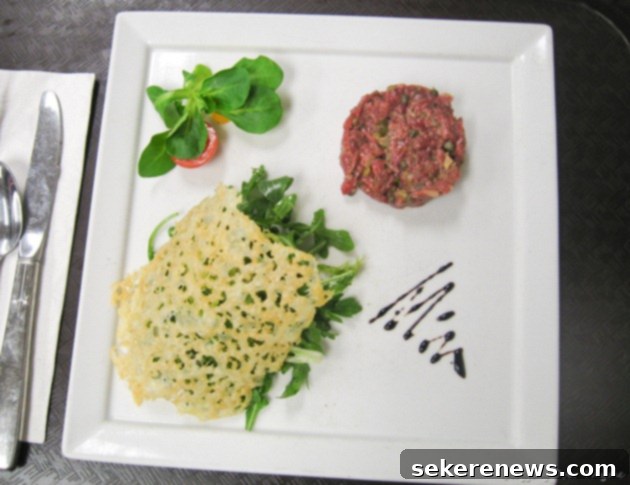
The Art of Precision: Crafting Classic Steak Tartare
Today’s menu kicked off with a deep dive into a true bistro classic: Steak Tartare. This dish, synonymous with traditional French cuisine, requires not just culinary skill but also an unwavering commitment to ingredient quality and meticulous hygiene. We worked with raw, lean top-round beef, finely diced and then artfully combined with a symphony of acidic and pungent components. Lemon juice, cornichons, capers, Dijon mustard, and finely minced red onion provided a sharp, refreshing counterpoint to the richness of the beef. A dash of Tabasco and Worcestershire sauce added depth and a subtle kick, while a fresh raw egg yolk acted as the perfect binder, emulsifying the ingredients into a cohesive, flavorful mixture.
The inherent nature of serving raw beef and egg yolks means that freshness and stringent sanitation are paramount. Every step, from sourcing the highest quality ingredients to maintaining precise temperatures and assembling the dish at the very last minute, is critical to ensuring both safety and optimal flavor. While the concept of raw beef might initially give some pause – especially given modern health consciousness – when executed flawlessly with the freshest ingredients, Steak Tartare is a testament to the purity of flavor and texture. It truly is a dish that challenges perceptions and expands one’s culinary palate.
To complement the richness of the tartare, we served it alongside a crisp arugula salad, offering a peppery contrast. The salad was elegantly garnished with a delicate Parmesan Tuile. These seemingly simple, yet incredibly effective garnishes, are crafted by arranging grated Parmesan cheese into thin circles on a Silpat mat, baking them until golden and crisp, and then, with impressive speed and precision, molding them into elegant curved shapes by draping them over a bottle. The key is quick execution; the cheese cools and hardens rapidly. The pure, nutty, salty flavor of the Parmesan added a fantastic textural element and another layer of savory sophistication to the dish. It’s these small, perfectly executed details that elevate a meal from good to exceptional in a professional kitchen.
A Taste of Spain: Mastering Seafood Paella
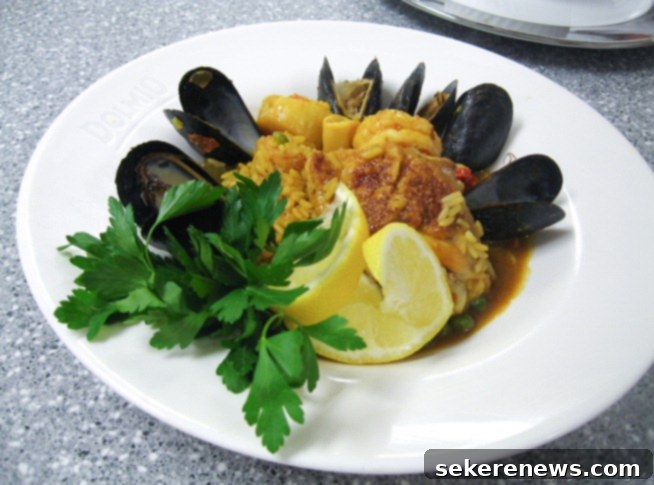
Our main course transported us to the sun-drenched shores of Spain with a robust and incredibly flavorful Paella. This iconic rice dish was brimming with a generous assortment of proteins, including tender chicken, succulent mussels, plump shrimp, delicate squid, and sweet scallops. The secret to its extraordinary depth of flavor lay in the meticulously prepared stock. Before even beginning the paella, we crafted a rich, aromatic broth by simmering chicken bones, a variety of vegetable scraps, seafood shells (especially shrimp shells which impart incredible depth), a fragrant fumet (fish stock), and classic chicken stock. This layered approach to stock-making ensures that every grain of rice and every piece of seafood is infused with maximum flavor.
The process of building a paella is an art form in itself, starting with sautéing aromatics, searing the proteins, and then slowly incorporating the rice, allowing it to absorb the complex stock. The goal is to achieve perfectly cooked rice with a beautiful crust at the bottom, known as socarrat – a highly prized element that signifies a truly authentic paella. The vibrant colors, the intoxicating aroma of saffron, and the harmonious blend of land and sea made this paella an absolute triumph. It was not just a meal; it was a celebration of Spanish culinary tradition, executed with the precision and passion required in a professional kitchen.
The Grand Finale: Chocolate & Grand Marnier Soufflé
Concluding our challenging day was a delicate and visually stunning dessert: a Chocolate & Grand Marnier Soufflé. This marked our first venture into soufflés in Phase II of the program, and there was a palpable sense of excitement and perhaps a little apprehension, given their reputation for being temperamental. Fortunately, the efforts paid off, with everyone achieving successful, beautifully risen creations. We revisited the fundamental principle that the basic base of a soufflé is a rich pastry cream, expertly crafted with flour (rather than cornstarch, which can sometimes result in a less stable structure), providing a robust foundation for the light and airy texture.
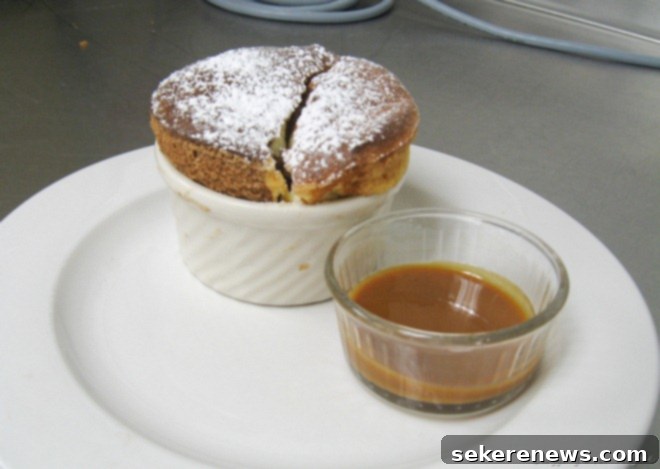
To make these soufflés particularly special, we employed an innovative technique using folded foil to create a divider, effectively separating the soufflé into two distinct halves within the ramekin. One side featured a rich, dark chocolate, while the other offered the bright, citrusy notes of Grand Marnier. This dual-flavor approach made for an incredibly fun and intriguing presentation, even if its subtle beauty is difficult to fully capture in a photograph. It demonstrated an advanced level of technique and creativity, turning a classic dessert into a unique experience.
We served these ethereal creations with a luscious caramel sauce. The traditional way of serving soufflés involves puncturing a small hole in the center of the soufflé at the table, allowing the warm sauce to be poured directly into its heart, creating a delightful molten core. While the immediate rush of class meant our soufflés weren’t at their peak fluffiness and warmth by the time we finally got to taste them, the flavor combination was undeniably delicious. The experience reinforced the critical importance of timing and swift service in high-end dining, where every second counts in delivering the perfect dish to the guest.
Preparing for the Ultimate Test: The Banquet Challenge
The afternoon was dedicated to intensive discussions and meticulous planning for tomorrow’s monumental Banquet Challenge. This is no ordinary class; it is a full-scale operation where we are tasked with preparing and serving a sophisticated 6-course meal for 75 people, encompassing the entire school, including Phase I pastry and culinary students who will be observing, many fresh from their sanitation classes. This challenge feels like the culmination of everything we’ve learned so far.
It seems like just yesterday, yet also so long ago, when I first started this program, feeling utterly intimidated by the sheer volume and complexity of food preparation in the professional kitchen. I distinctly remember wondering if we would ever reach the point where we could orchestrate such an event ourselves. Well, tomorrow is that day. The anticipation is immense, a mix of nerves and exhilaration as we prepare to put all our skills – from mise en place and precision cooking to timing and presentation – to the ultimate test. It’s a true measure of our growth and readiness for the industry.
Flashback: Our First Market Basket Challenge
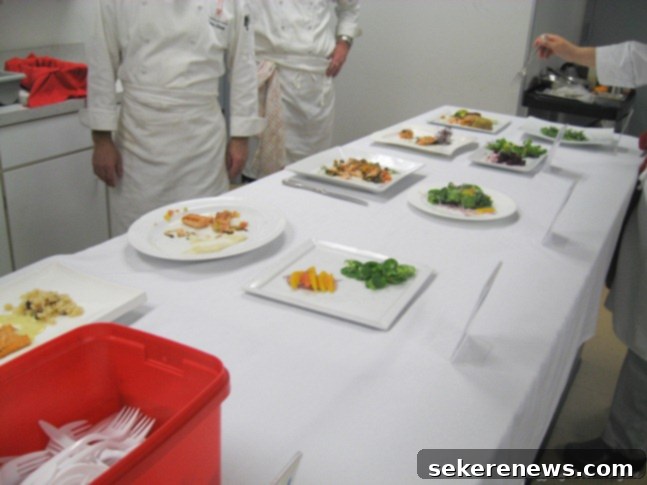
Taking a quick look back to last Friday, we faced our very first Market Basket challenge – a significant addition to our Phase II curriculum, which will now feature these high-pressure competitions nearly every week. The format is designed to test our adaptability and creativity: the day before the challenge, we are presented with a selection of mandatory ingredients, all of which must be incorporated into a cohesive 3-course meal. We then have the afternoon to collaborate with our teammates, brainstorm ideas, and meticulously plan our menu. The following morning, the real challenge begins as we execute our vision under intense scrutiny. To further elevate the stakes, visiting chefs from various establishments in the area come to the school to judge our plates directly in front of us and the entire class, providing immediate, often candid, feedback.
Our inaugural Market Basket was a ‘mini’ version, a one-course challenge (main dish + side) due to it being a half-day and our very first experience. The star ingredient was salmon, and our dishes were judged by none other than our director, Chef Francois. My teammate Jim and I decided to present a beautifully pan-seared or Grilled Salmon Filet with a vibrant Lemon Parsley Sauce, elegantly served on a bed of roasted zucchini and summer squash. For our accompanying side, we prepared a simple yet refreshing Baby Spinach Salad, tossed with a bright Orange Vinaigrette, crunchy Toasted Almonds, juicy Orange Segments, and finely sliced Red Onions. Overall, we received encouraging feedback, validating our efforts and flavor combinations. However, Chef Francois did express a particular disinterest in our roasted squash, noting that he found them a bit bitter – a valuable lesson that even personal preferences can influence judgment in the professional culinary world. It was an invaluable learning experience, highlighting the importance of not just technical skill, but also understanding palates and adapting on the fly.
Looking ahead, this coming Friday will bring our second Market Basket challenge, a full three-course competition, and this time, we’ll be judged by an external chef. The pressure is certainly mounting, but so is our determination to refine our skills and deliver exceptional results. These challenges are not just about winning; they are about honing our ability to think on our feet, work cohesively as a team, and consistently produce high-quality dishes under demanding circumstances.
I’ll be back tomorrow with a comprehensive update on our intensive Banquet Challenge, sharing the triumphs, the hurdles, and all the lessons learned from this ultimate test of our culinary prowess!
